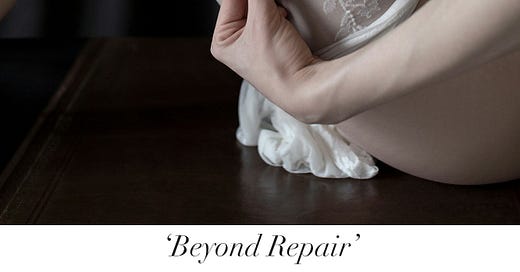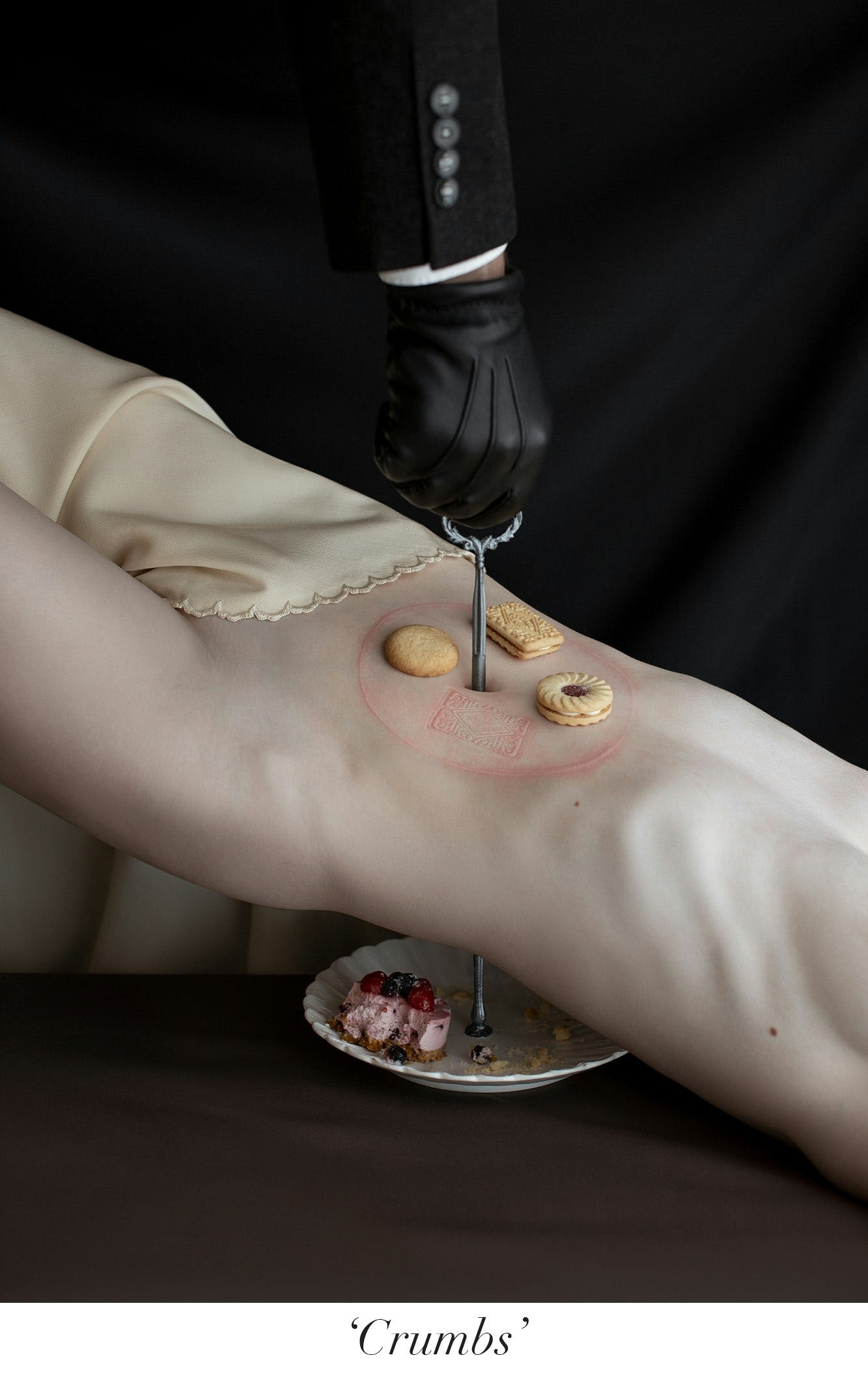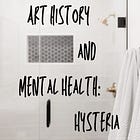From Neurasthenia to Shadowbanning
How Diverse Embodied Experiences are Rendered Invisible Under the Guise of “Protecting The Public From Harm”
I’ve shared with you the history of neurasthenia, an outdated mental health diagnosis, as it intersects with art history, so I thought perhaps you might be interested in something I wrote last semester for a Visual and Critical Studies class that relates to this topic. I’ve removed some of the most academic stuff (like the literature review) but kept the rest as I wrote it, even though it doesn’t quite come to a conclusion. My intention was to expand this into a thesis, but then I decided that this wasn’t the topic that I wanted to pursue after all, switching instead to writing about craftivism which is more where my heart is, but I do think there’s something to be explored further here …
Abstract
Visual artworks depicting the embodied experiences of trauma, chronic pain and mental illness are routinely shadow banned by social media sites. Iness Rychlik, a white woman with a rare, sensitive skin condition, and Julian Gavino, a white transgender man who uses a feeding tube and wheelchair, offer two examples of artists who create self-portraits from lived experience that provoke discomfort among censors due to their intersectional identities, disrupting conventional perceptions of beauty and normalcy. The shadowbanning of these contemporary artists parallels historical practices of erasure and infantilization, as seen in 19th-century paintings of white, upper-class women. During this era, male doctors routinely disregarded women's autonomy and prescribed the "rest cure" to manage various ailments, reinforcing patriarchal power dynamics. Similarly, modern algorithms perpetuate these historical biases by rendering certain bodies invisible, thus perpetuating limiting narratives and hindering progress toward inclusivity and equity online. From a feminist intersectional lens, informed by psychological theories, identity studies, disability studies, and media studies, this paper argues that the systemic erasure of these bodies perpetuates historical power dynamics and hinders progress toward inclusivity and equity online. Specifically, censorship of these artworks stems from societal discomfort with confronting issues of trauma and illness, compounded by the artists' intersecting identities. Removing censorship enables a more authentic representation of diverse experiences, fostering understanding and challenging systemic biases within digital platforms.
Silencing Through Shadowbanning
Shadowbanning by social media sites censors artworks, such as the work of self-portraiture artist Iness Rychlik, that display bodily experiences of trauma, chronic illness and (dis)ability. This mirrors the longtime minimization, obfuscation, and insistence upon invisibility that the mainstream media and dominant majority have used to silence, incapacitate and oppress individuals with “invisible” or “less visible” illnesses/differences, perpetuating systemic biases and power imbalances. The artworks themselves, including Rychlik’s “Beyond Repair” and Julian Gavino’s “Jeans with Gender Dysphoria and Disability" serve as potent vehicles for challenging silence and presenting alternative discourses on trauma and chronic illness.
Geoffrey A. Fowler (The Washington Post, 2022), describes shadowbanning as "a form of online censorship where you’re still allowed to speak, but hardly anyone gets to hear you." Artists may find their posts buried in search results or hidden from followers, effectively limiting their impact and silencing their voices within online spaces. Within the context of artists addressing mental health challenges, shadowbanning manifests as a hindrance to the dissemination of their artwork and the critical conversations it engenders. This suppression not only restricts the reach of the artworks but also contributes to the perpetuation of stigma surrounding mental illness.
By analyzing specific shadowbanned artworks, such as "Crumbs," a self-portrait by Iness Rychlik (2022), we can discern the underlying messages and themes that provoke such censorship. The artwork features the artist's pale white body as a canvas, with her hips elevated over a scalloped plate, adorned with a delectable pink dessert. Delicate cookies balance atop her stomach, forming a circle that hints at both indulgence and restraint. Yet, amidst this seemingly whimsical scene, the stark contrast of temporary pink scars serves as a visceral reminder of her ongoing chronic pain. The composition is punctuated by the unexpected intrusion of a black-gloved hand, piercing through the artist's belly button with what appears to be a key—a jarring juxtaposition that blurs the boundaries between pleasure and suffering. Instagram's censorship of "Crumbs," under the guise of "soliciting sex and promoting self-harm/suicide," reflects a broader pattern of discrimination against artists confronting the experience of how trauma lives in the body. “Crumbs” shows the remnants of pain left behind on the body from food, speaking not just to the artist’s own experience of how objects mark her body but also to the complicated and painful history that many women have with food and their bodies. Rather than solicitation of sex, the headless body holds a pose that suggests tension between the desire for sensual experience and the pain associated with having it forced onto you.
Shadow Banning: The 21st Century “Rest Cure”
Iness Rychlik's artistic style is deeply inspired by the romanticized imagery of wealthy white women prevalent in nineteenth-century aesthetics. This aesthetic choice is fascinating in that it draws from a period of history in which middle and upper class white women were often infantilized, dismissed for their concerns through diagnoses such as “hysteria” while simultaneously being told that they were fragile and shouldn’t bother themselves with “silly little things” such as politics and art. This manifested dramatically in a “period illness” called neurasthenia, primarily assigned to American middle- and upper class women in the late 19th century, a diagnosis of “nervous exhaustion” caused by the stressors of modern life and also deeply tied to the female body as misunderstood by male doctors. Katherine Williams writes in “American Women and “Nervousness” (Williams, 2004), “Reproductive events, such as puberty, pregnancy, and menopause, even if uncomplicated by illness or trauma, were also considered important in the onset of neurasthenia because these bodily changes required so much energy.”
Williams’ essay is included in the exhibition catalog for "Women on the Verge: The Culture of Neurasthenia in Nineteenth-Century America," an exhibit that featured 8 well-known portrait paintings of women by men of that era in a recreated Victorian room alongside texts providing insight into the repression of women through this diagnosis.
One of the paintings featured in the exhibit was Thomas Wilmer Dewing’s “Lady in White (No. 2.),” a 1910 oil painting depicting a women enveloped in an aura of contemplative exhaustion, characteristic of the neurasthenic archetype prevalent in nineteenth-century culture. The woman, hair pinned up, sits in profile, upright in a chair, gazing without purpose or seeming interest at an empty space. She sits at a table atop which is a wide curved vase, positioned so that the eye of the viewer is as drawn to it as it is to the women; both appear to be inanimate objects. The entire painting is washed with a brown-gold-green hue that, combined with the evident brushstrokes in the woman’s dress, creates a feeling that the entire scene is passive, wavering, almost ghostly. Zachary Ross describes this painting as an example of the ideal of “The Woman at Home, in this therapeutic construct, (she) is in the process of becoming: on the verge of neurasthenia, she achieves repose and eases her psychic tensions.” Women diagnosed with neurasthenia were assigned “the rest cure,” meaning that they were told to get into bed, for days, weeks, sometimes months in a row, and to do absolutely nothing. They were discouraged from reading, from creating art, from exercising. Sometimes they weren’t even allowed to feed themselves, instead they were assigned a nurse to feed them like a child. Predictably, this often made their mental health worse, rather than better, under the guise of an expert knowing more about their bodies and minds than they did.
Rychlik’s work boldly stakes her claim that she is the expert on her own body and may portray its truth in whatever way is right for her. In "Beyond Repair," Rychlik turns her hyper-sensitive skin condition into her canvas. Her pose is reminiscent of the pose seen in Thomas Wilmer Dewing's "Lady in White, No. 2." However, unlike the passive portrayal of the woman in Dewing's painting, Rychlik's subject exudes agency of her own body. Her head hangs down, obscuring her face with her hair, symbolizing a sense of introspection and vulnerability that comes from within rather than being imposed from an external doctor or professional. Whereas Lady in White sits politely with her hands in her lap, Rychlik holds a pin in one hand, with which she has torn a hole into her white stockings, inscribing a delicate flower into her skin. Rychlik’s flower is in direct contrast to the flower vase as a passive object in Dewing’s painting, emanating a dynamic and assertive presence. Through her art, Rychlik confronts the viewer with the raw reality of her experience, challenging our notions of pain and pleasure, beauty and illness.
And yet, this image, which does not even depict full nudity or obvious bleeding, has been shadow banned by Instagram. Shadow banning of art that depicts women’s bodies in their full experience of trauma, chronic pain, and physical manifestations of mental health mirrors this outdated idea that the “experts” know what is best for us; they reduce “reach” and make these voices invisible with the claim that it’s for the good of the viewers. Presumably, work banned for “solicitation of sex” or depictions of “self-harm” are so threatening to the general public viewing social media sites that they must be hidden from view, much like the women told to go rest in their rooms in the 19th century.
Because it is done behind the scenes instead of out in the open, shadowbanning mirrors the historical and contemporary denial, minimization, and dismissal of the artists with chronic health challenges, akin to gaslighting and downplaying the extent of censorship faced by these artists, perpetuating their marginalization. Social media algorithms, designed and controlled by predominantly homogeneous groups, reflect and perpetuate existing hierarchies of power. Consequently, voices that challenge established norms or advocate for marginalized perspectives are systematically silenced or relegated to the margins. The selective amplification of certain voices while marginalizing others reinforces existing power structures, further entrenching inequities in online discourse. By relegating these voices to the periphery, social media platforms perpetuate existing power differentials, effectively silencing dissent and reinforcing hegemonic narratives. The opacity surrounding shadowbanning complicates efforts to combat censorship effectively. Social media companies often cloak their practices in ambiguity, using terms like "deamplification" or "reach reduction" to obfuscate their actions. This lack of transparency impedes accountability and perpetuates systemic injustices, particularly for artists whose work challenges dominant narratives.
Issues of Intersectionality
One notable initiative shedding light on shadowbanning is THE UNSEEN project. Developed by Rankin Creative, THE UNSEEN aims to amplify artwork that has been unfairly de-platformed online. Through an exhibition and online showcase, it provides a platform for censored and shadowbanned artwork, fostering a community of artists whose voices have been marginalized. By highlighting the human consequences of censorship, THE UNSEEN underscores the urgency of addressing systemic inequities in online spaces.
Their work has drawn attention to how the loss of visibility on a social media site translates to an artist’s loss of income, loss of community, and loss of authentic self-expression. Moreover, repeated censorship can result in mental health trauma. Mental health specialist Dr. Neeta Bhushan explains, “Being told over and over again that you are ‘inappropriate’ or unwanted, simply for being yourself is both exhausting and traumatizing for users.” (Brown, 2021). Rychlik herself has explicitly stated (2023), “Photography has been instrumental in my journey of overcoming psychological trauma and embracing my physical skin disease.”
In ways other than being a woman with chronic health issues, though, Rychlik appears, at least on the surface, to embody many of the identity factors of the dominant majority: she presents as cis-gender, thin, and white, to name a few factors. I bring this up because central to the discussion of shadowbanning is its intersectional implications. While Rychlik's identity aligns with certain societal norms, and she has perhaps managed to receive some artistic success despite shadow banning, artists from marginalized communities face compounded challenges. Factors such as race, gender, sexuality, and body size intersect with disability to exacerbate invisibility and censorship, something that has been historically true and is mirrored in shadow banning. This intersectionality necessitates a nuanced understanding of how power dynamics operate within online spaces, privileging certain voices while marginalizing others.
THE UNSEEN provides us with examples of such intersectionality that must be explored in more depth as this research continues. For example, let’s look at the case of Julian Gavino, a queer disabled model, which underscores the intersectional nature of shadowbanning, where multiple marginalized identities intersect to exacerbate invisibility and censorship. Julian Gavino's art piece titled "Jeans with Gender Dysphoria and Disability" offers a poignant visual commentary on the intersectional challenges faced by marginalized individuals in online spaces. In this mirror selfie, Gavino is seated in his wheelchair, one hand on the wheel and the other holding the phone camera, capturing his own reflection. He appears topless, with one nipple visible, and a small glimpse of his feeding tube on his abdomen. The top button and zipper of his jeans are undone, revealing his stomach slightly protruding. In the image’s caption, and in interviews and essays elsewhere online, Gavino uses photography to express the challenges of living in a medically-challenged body, addressing body dysphoria, wheelchair accessibility issues, and the difficulty of finding jeans that fit a stomach always changing in size due to GI health issues. Sharing this body in the ways he chooses to do so, he experiences censorship and erasure through shadow banning, particularly regarding his feeding tube, which is flagged as "gore or violence”. The realistic portrayal of medical devices such as this are often flagged in this way by the algorithms. Gavino’s topless photos have been banned for showing nipples; he identifies as a man but is flagged because he is trans whereas cis gender men are widely allowed to show topless photos. Gavino’s intersectional identity as a transgender man with disabilities, visible in the details of his photography, underscores the complexity of his online experiences, where multiple marginalized identities intersect to exacerbate invisibility and censorship.
If you read this far, perhaps you liked the work. The work does take work. It only continues with support, so please consider subscribing. My annual rate starts at $10 per year.










Fascinating read. Makes me mad that even automated algorithms keep up this kind of censorship, and simultaneously glad that I use very little social media.
Informative